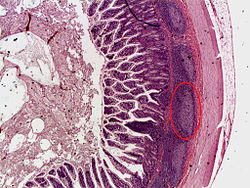Peyer's patches
| Peyer's patch | |
|---|---|

Cross section of ileum with a Peyer's patch circled.
|
|
| Details | |
| System | Immune system (Lymphatic system) |
| Identifiers | |
| Latin | noduli lymphoidei aggregati |
| Code | TH H3.04.03.0.00020 |
| TA | A05.6.01.014 |
| TH | H3.04.03.0.00020 |
| FMA | 76466 |
|
Anatomical terminology
[]
|
|
Peyer's patches (or aggregated lymphoid nodules, or occasionally PP for brevity) are organized lymphoid follicles, named after the 17th-century Swiss anatomist Johann Conrad Peyer. They are an important part of gut associated lymphoid tissue usually found in humans in the lowest portion of the small intestine, mainly in the distal jejunum and the ileum, but also could be detected in the duodenum.
Peyer's patches are observable as elongated thickenings of the intestinal epithelium measuring a few centimeters in length. About 100 are found in humans. Microscopically, Peyer's patches appear as oval or round lymphoid follicles (similar to lymph nodes) located in the submucosa layer of the ileum and extend into the mucosa layer. The number of Peyer's patches peaks at age 15–25 and then declines during adulthood. In the distal ileum, they are numerous and they form a lymphoid ring. At least 46% of Peyer's patches are concentrated in the distal 25 cm of ileum in humans. It is important to note that there are large variations in size, shape, and distribution of Peyer's patches from one individual to another one. In adults, B lymphocytes are seen to dominate the follicles' germinal centers. T lymphocytes are found in the zones between follicles. Among the mononuclear cells, CD4+/CD25+ (10%) cells and CD8+/CD25+ (5%) cells are more abundant in Peyer's patches than in the peripheral blood.
Peyer's patches are characterized by the follicle-associated epithelium (FAE), which covers every lymphoid follicles. FAE differs from typical small intestinal villus epithelium: it has fewer goblet cells therefore mucus layer is thinner, and it is also characterized by the presence of specialized M cells or microfold cells, which provide uptake and transport of antigens from lumen. Moreover, basal lamina of follicle-associated epithelium is more porous compare to intestinal villus. Finally, follicle-associated epithelium is less permeable for ions and macromolecules, basically due to higher expression of tight junction proteins.
...
Wikipedia
